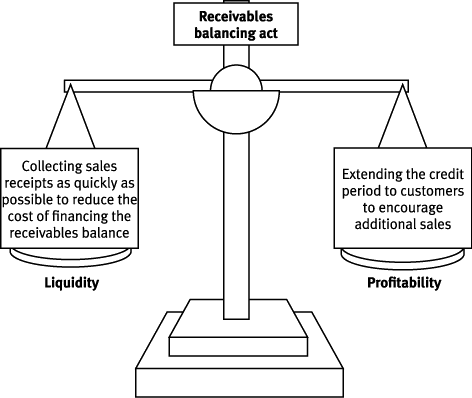Debtors/receiveables management
Managing debtors / receivables is a key aspect of working capital management.
The objectives of accounts receivable management is to ascertain the optimum level of trade credit to offer customers and to manage that credit.
The amount of credit represents a balance between two factors:
Importance of receivables management
Allowing credit to customers will encourage sales, or at least the absence of the availability of credit will encourage customer to select an alternative supplier offering more favourable credit terms.
Allowing too much credit, or not managing the credit policy carefully enough, could result in irrecoverable debts. This represents a loss of income to the company, affecting both profitability and cash flow.
The balancing act: Profitability v Liquidity

Credit policy
As part of the management of accounts receivable, a company must establish a credit policy. This policy will be influenced by:
Importance of having a credit policy
A firm must establish a policy for credit terms given to its customers. Ideally the firm would want to obtain cash with each order delivered, but that is impossible unless substantial settlement (or cash) discounts are offered as an inducement. It must be recognised that credit terms are part of the firm's marketing policy. If the trade or industry has adopted a common practice, then it is probably wise to keep in step with it.
Assessing creditworthiness
To minimise the risk of irrecoverable debts occurring, a company should investigate the creditworthiness of all new customers immediately and should continue to assess existing customers periodically.
Information for assessing creditworthiness may come from a variety of sources, such as bank references, trade references, competitors, published information, credit reference agencies. company sales records or credit scoring.
Credit limits
Credit limits should be set for each customer to reflect both the amount of credit available and the length of time allowed before payment is due. A ledger account should be set up and monitored for each customer.
Invoicing and collecting overdue debts
A credit period only begins once an invoice is received so prompt invoicing is essential. If debts are allowed to go overdue, the risk of default increases, therefore a system of follow-up procedures is required.
Most companies would typically follow a collection procedure such as:
Monitoring the system
The position of receivables should be regularly reviewed as part of managing overall working capital and corrective action taken when needed. Methods used in monitoring the credit system would include aged debt analysis, financial ratios and statistical data.
Cost of financing receivables
The cost of financing receivables is generally taken to be the cost to the company of an overdraft the size of the receivables balance. It can be calculated as follows:
Early settlement discounts
Cash discounts are offered to customers to encourage early payment. The cost of the discount is balanced against the savings the company receives from having less capital tied up due to a lower receivables balance and a shorter average collection period. Discounts may also reduce the number of irrecoverable debts.
Annual cost of a discount
The calculation of the annual cost of a discount can be expressed as a formula:

Notice that the annual cost calculation is always based on the amount left to pay, i.e. the amount net of discount.
If the cost of offering the discount exceeds the rate of overdraft interest then the discount should not be offered.
Factoring
Factoring is the outsourcing of the credit control department to a third party.
The debts of the company are effectively sold to a factor (normally owned by a bank). The factor takes on the responsibility of collecting the debt for a fee.
Factoring is primarily designed to allow companies to accelerate cash flow, providing finance against outstanding trade receivables. This improves cash flow and liquidity. Factoring is of particular value to smaller firms or fast growing firms.
Recourse or non-recourse
Factoring can be arranged on either a 'without recourse' basis or a 'with recourse' basis.
When factoring is without recourse or 'non-recourse', the factor provides protection for the client against irrecoverable debts. The factor has no 'comeback' or recourse to the client if a customer defaults. When a customer of the client fails to pay a debt, the factor bears the loss and the client receives the money from the debt.
When the service is with recourse ('recourse factoring'), the client must bear the loss from any irrecoverable debt, and so has to reimburse the factor for any money it has already received for the debt.
Credit protection is provided only when the service is non-recourse and this is obviously more costly.
Typical factoring arrangements
The company can choose some or all of the following services offered by the factor:
(1) administration and debt collection
(2)financing
Administration and debt collection
Including financing
Invoice discounting
Invoice discounting is a method of raising finance against the security of receivables without using the sales ledger administration services of a factor.
While specialist invoice discounting firms exist, this is a service also provided by a factoring company. Selected invoices are used as security against which the company may borrow funds. This is a temporary source of finance, repayable when the debt is cleared. The key advantage of invoice discounting is that it is a confidential service,and the customer need not know about it.
In some ways it is similar to the financing part of the factoring service without control of credit passing to the factor.
|
Created at 8/17/2012 2:02 PM by System Account
(GMT) Greenwich Mean Time : Dublin, Edinburgh, Lisbon, London
|
Last modified at 12/17/2013 2:09 PM by System Account
(GMT) Greenwich Mean Time : Dublin, Edinburgh, Lisbon, London
|
|
|
|
 |
Rating
:
|
 Ratings & Comments
(Click the stars to rate the page) Ratings & Comments
(Click the stars to rate the page)
|
 |
Tags:
|
|
|
|
|